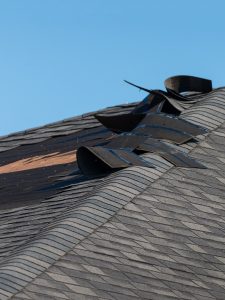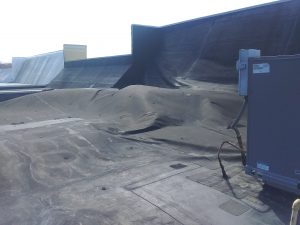Beware of Wind Damage to Your Roof
 The effects of wind damage to your roof should never be overlooked since it is just as damaging as hail, ice, rain or snow. It can undermine the durability of your roof and end up costing you big. It is important to be aware of the potential problems wind damage can cause your roof and check for them after a windstorm.
The effects of wind damage to your roof should never be overlooked since it is just as damaging as hail, ice, rain or snow. It can undermine the durability of your roof and end up costing you big. It is important to be aware of the potential problems wind damage can cause your roof and check for them after a windstorm.
How to Spot
After high winds have come through your area, look around the perimeter of your home or building since this is where damage will most likely begin. Check the edge of your fascia to help determine if you might need repairs or look to see if there are any wrinkles or bubbles in the roofing membrane. Also, be aware that the older the roof and the stronger the wind, the chance of sustaining of damage is higher.
How it Affects Different Types of Roofs
A sign to look for on a shingled roof is when the shingles are uplifted, loose, or if you see thin horizontal lines across the shingles. Shingled roofs are installed with nails, but sometimes that’s not enough against strong winds. GAF combats this by using Dura Grip  Advanced Sealant and even tested it against category 4 hurricane winds which they show in this video. With a metal roof, you can spot wind damage by checking for kinks and folds. If you do need repairs, a good fix is a metal retrofit with a PVC membrane since it can save you the cost of having to completely remove the metal roof.
Advanced Sealant and even tested it against category 4 hurricane winds which they show in this video. With a metal roof, you can spot wind damage by checking for kinks and folds. If you do need repairs, a good fix is a metal retrofit with a PVC membrane since it can save you the cost of having to completely remove the metal roof.
With a ballasted roof, wind damage is more likely to occur if the gravel becomes undistributed and exposes the membrane underneath. At that point, there is nothing holding down the membrane to the decking material. It is then easier for wind damage to take place. When you have a membrane, it is more common that the wind damage to your roof is caused by wind uplift. That can be seen more often in buildings with large doors, like warehouses.
Wind Uplift Damage to Roofs
Wind uplift is caused when the wind pressure above the building is reduced and the pressure is higher inside the building. This difference in  pressure causes the roof to be pushed up and become loose. When this happens, water can get under the membrane. To prevent wind uplift, check the metal edge flashing and make sure that the fascia is fastened down. If you find that anything is loose there is a good chance that wind damage will happen to your roof during the next windstorm. Even if there is only a small gap in the membrane, that is more than enough for the wind to take ahold of and tear off the flashing which will end up costing you more.
pressure causes the roof to be pushed up and become loose. When this happens, water can get under the membrane. To prevent wind uplift, check the metal edge flashing and make sure that the fascia is fastened down. If you find that anything is loose there is a good chance that wind damage will happen to your roof during the next windstorm. Even if there is only a small gap in the membrane, that is more than enough for the wind to take ahold of and tear off the flashing which will end up costing you more.
It’s important to inspect your roof regularly to ensure it maintains its integrity in all areas to prepare for strong winds. If you believe that you have any wind damage to your roof, call us at 800-303-8392 and we can come out to check it out.
Posted by Leona Burton


